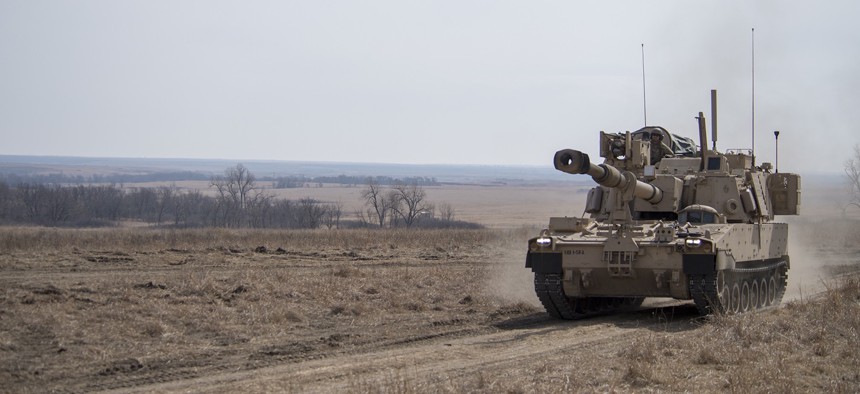
The U.S. Army tests an upgraded M109 Paladin howitzer at Fort Riley, Kansas, in 2018. U.S. Army
Taiwan Wants Paladins. Congress Should Say No
Taipei’s only hope for an effective defense is not armor but asymmetry.
The Biden administration recently notified Congress of a proposal to sell Taiwan 40 Paladin self-propelled howitzers. As mundane as this announcement might seem, it should be of deep concern to anyone who cares about U.S.-Taiwan relations.
Beijing is, after all, ratcheting up its aggression toward the island. A war over Taiwan’s status is a distinct possibility and would prove unimaginably catastrophic for Taiwan. Americans also have skin in the game, since Washington will face enormous pressure to intervene.
Taiwan should therefore do everything it can to deter China by improving its defenses. Unfortunately, this proposed sale is stark proof that far from undertaking long overdue defense reforms with a sense of existential urgency, Taiwan is acting like it is business as usual.
Make no mistake: Paladins are a bad idea. They are outdated, based on a design that dates back to the Vietnam War. They are also expensive. Taiwan will spend $750 million on 40 howitzers. That is before training, maintenance, and ammunition costs are factored in. Worst of all, Paladins will be sitting ducks in a shooting war. At 10 feet tall, 10 feet wide, and 30 tons in weight, these vehicles are ill-suited for the island’s endless winding roads, narrow bridges, and waterlogged fields.
The fact is that Paladins are exactly the sort of weapon that defense experts have long tried to get Taipei to stop buying. Most serious analysts think that Taiwan already spends too much on small numbers of expensive platforms. Since Taiwan's military cannot possibly afford enough jets, ships, and tanks to offset the ever-growing cross-Strait military imbalance, over-investing in these weapons makes the island dangerously vulnerable to first strike and preemption.
American analysts and think tanks have instead tried to get Taiwan to adopt an asymmetric force posture. Asymmetry means reorganizing the island’s defense around large numbers of cheap things—weapons like drones, coastal defense missiles, naval mines, portable air defenses, and mobile ground forces. It also means training combat units to wage a prolonged defense in depth instead of trying to engage an invasion force in a decisive battle for the beaches.
Taiwanese admirals and generals counter this push for asymmetry by claiming they need expensive jets and ships to respond to China’s so-called “grey zone” provocations. Although it is unclear how Paladins will help with this task, the more important point is that naval and aerial intrusions alone cannot bend the will of a truly resolute people. If they can, then it means Taiwan has far deeper problems than American-made weapons alone can solve.
Instead of piddling around in the grey zone, Taiwan’s military should focus on the real threat: invasion. A genuinely asymmetric force posture is its best option for doing so.
For a short time, it seemed like this message was getting through to Taipei. President Tsai prioritized asymmetric defense reform at the start of her second term. Taiwan’s military even flirted with the innovative and asymmetric Overall Defense Concept.
Unfortunately, Taiwan’s pursuit of Paladins serves as yet more proof that these moves were just lip service and that Taiwan’s military remained unserious about asymmetry. In 2019 alone, Taiwan spent $8 billion on 66 F-16 fighter jets and another $2 billion on 108 M1A2 Abrams main battle tanks. The Tsai administration still wants to spend $16 billion USD on eight indigenously developed and built submarines. And Taiwan’s 2021 Quadrennial Defense Review makes clear in substance and style that asymmetry remains a low priority.
Of course, the blame is not Taiwan’s alone. Despite pushing for asymmetric defense reform, the United States continues to send mixed signals about what it will sell the island. If American officials are as serious about asymmetry as they say they are, they would have squelched the Paladin deal long ago.
The Executive and Legislative Branches need to get on the same sheet of music. Their message must be clear: Taiwan has all the tanks, planes, and ships it needs. The United States will stand firm by its commitment to “make available to Taiwan such defense articles and defense services in such quantity as may be necessary to enable Taiwan to maintain a sufficient self-defense capability” However, Washington—not Taipei—will define “sufficient self-defense capability” from here on out.
Taiwan is a thriving liberal democracy and a critical partner of the utmost geostrategic importance. It is a friend worth helping. Yet there is a difference between being a friend and being an enabler. Even if the Paladin deal is too far along to stop without losing face, the United States must find a way to get the island to stop squandering its limited time, money, and resources on inappropriate weapons. Getting Taiwan’s military to change course will of course be difficult, costly, and painful. The price tag for ignoring the problem will almost assuredly be higher.
Brian Davis is a Ph.D candidate at George Mason University’s Schar School of Policy and Government. He is a retired U.S. Army Foreign Area Officer.
Michael A. Hunzeker is an Assistant Professor at George Mason University’s Schar School of Policy and Government and a Senior Non-Resident Fellow at the Center for Strategic and Budgetary Assessments. He served as an active duty Marine Corps armor officer from 2000-2006.
NEXT STORY: The Next Big Refugee Crisis Just Started



